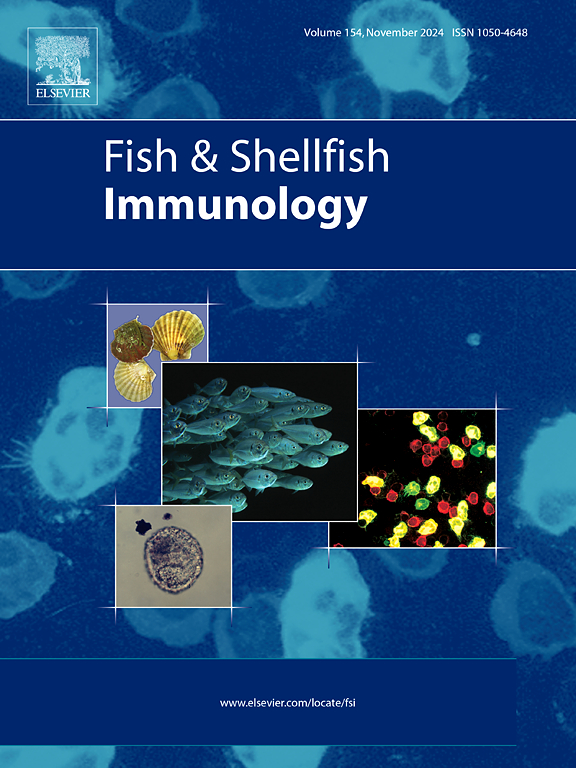黑岩鱼骨骼肌热休克蛋白基因家族的全基因组鉴定及其对慢性热应激的响应
IF 3.9
2区 农林科学
Q1 FISHERIES
引用次数: 0
摘要
作为分子伴侣,热休克蛋白(HSPs)在应激条件下迅速上调,保护细胞免受热、机械损伤和化学试剂引起的损伤。尽管HSP基因具有重要的生理作用,但对于具有重要商业价值的沿海底栖鱼类——施莱格里塞巴斯(sebases schlegelii)来说,目前还缺乏对HSP基因的全基因组分析。在这项研究中,我们系统地鉴定了HSP基因家族并分析了其表达谱。在施莱格氏链球菌基因组中共鉴定出103个热休克蛋白基因。系统发育分析(种间和种内分析),结合保守基序和结构域特征,将这些热休克蛋白分为6个亚家族:Hsp20 (Hspb), Hsp40 (Dnaja/Dnajb/Dnajc), Hsp60 (Hspd1/Cct/Bbs), Hsp70 (Hspa), Hsp90和Hsp100 (Clp)。基序和结构域分析显示,与其他HSP组相比,Hsp70和Hsp90亚家族的序列保守性明显更高。染色体定位结果表明,HSP基因分布在施勒格氏血吸虫的24条染色体上,但密度不同。基因重复分析在HSP家族中发现了6个全基因组/片段重复事件和3个串联重复对。观察到的Ka/Ks比值(本文章由计算机程序翻译,如有差异,请以英文原文为准。
Genome-wide identification of heat shock protein gene family and their response to chronic heat stress in skeletal muscle of black rockfish (Sebastes schlegelii)
Functioning as molecular chaperones, heat shock proteins (HSPs) are rapidly upregulated under stress conditions, safeguarding cells against damage induced by heat, mechanical injury, and chemical agents. Despite their critical physiological roles, a comprehensive genome-wide characterization of HSP genes has been lacking for Sebastes schlegelii, a commercially important coastal benthic fish. In this study, we systematically identified the HSP gene family and analyzed its expression profiles. A total of 103 HSP genes were identified within the S. schlegelii genome. Phylogenetic analysis (interspecific and intraspecific analyses), coupled with conserved motif and domain characterization, classified these HSPs into six subfamilies: Hsp20 (Hspb), Hsp40 (Dnaja/Dnajb/Dnajc), Hsp60 (Hspd1/Cct/Bbs), Hsp70 (Hspa), Hsp90, and Hsp100 (Clp). Motif and domain analyses revealed significantly higher sequence conservation within the Hsp70 and Hsp90 subfamilies compared to other HSP groups. Chromosomal mapping indicated that HSP genes are distributed across all 24 chromosomes of S. schlegelii, albeit with varying densities. Gene duplication analysis identified 6 whole-genome/segmental duplication events and 3 tandem duplication pairs within the HSP family. The observed Ka/Ks ratios (<1) provide evidence for purifying selection acting on these sequences. Protein-protein interaction (PPI) network analysis predicted that Hsp70 subfamily members potentially receive regulatory inputs from other subfamilies, while Hsp40 members primarily functioned as co-chaperones. Notably, Hsp genes are ubiquitously expressed across the ten adult tissues, with the majority of family members (70.87 %) exhibiting the highest expression in the brain and ovarian tissues, suggesting coordinated functions in fundamental cellular processes. Following one month of chronic heat exposure (27 °C), S. schlegelii significantly upregulated 16 chaperone genes, indicating transcriptome-level thermal adaptation. This study provides the first systematic characterization of the HSP gene family in S. schlegelii, establishing a foundation for future functional investigations and identifying potential genetic targets for breeding thermotolerant aquaculture strains.
求助全文
通过发布文献求助,成功后即可免费获取论文全文。
去求助
来源期刊

Fish & shellfish immunology
农林科学-海洋与淡水生物学
CiteScore
7.50
自引率
19.10%
发文量
750
审稿时长
68 days
期刊介绍:
Fish and Shellfish Immunology rapidly publishes high-quality, peer-refereed contributions in the expanding fields of fish and shellfish immunology. It presents studies on the basic mechanisms of both the specific and non-specific defense systems, the cells, tissues, and humoral factors involved, their dependence on environmental and intrinsic factors, response to pathogens, response to vaccination, and applied studies on the development of specific vaccines for use in the aquaculture industry.
 求助内容:
求助内容: 应助结果提醒方式:
应助结果提醒方式:


